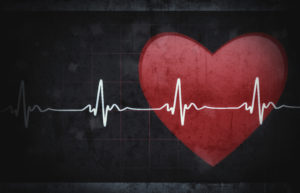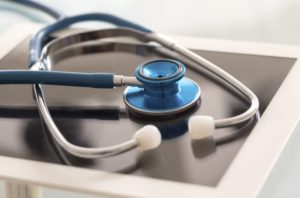Biometric technology, as we outlined in this month’s primer, can be used not only for security in healthcare and patient identification but also as a way of taking the hospital home. While the former two of these technology paradigms is focused on authentication and the latter on monitoring and data analytics, they both serve to address the same larger issue in hospitals and clinics: resource efficiency.
Biometric security offers a solution for time poor doctors – enabling things like electronic health records and easy but strong physical access control – and identification technologies deliver administrative efficiency. When it comes to vital biometrics, though, the resource being freed up is physical space. Innovations in mobility, wearable tech and vital biometrics are allowing chronic patients to stay home and receive round the clock care. Remote care solutions are gaining traction too, finding support from the American Medical Association, and at this year’s HIMSS conference, where Dr. Roy Schoenberg predicted major market growth in 2015.
Today, we’re going to take a look at three vital biometrics technologies that help illustrate the remote healthcare revolution underway right now.
Phelps Memorial Hospital Center Cuts Down Re-Admissions With Biometric Monitoring
 The New York-based healthcare institution, Phelps Memorial Hospital Center, recently implemented a comprehensive telehealth solution that is driven by biometric remote monitoring. The aim is to cut down on re-admissions.
The New York-based healthcare institution, Phelps Memorial Hospital Center, recently implemented a comprehensive telehealth solution that is driven by biometric remote monitoring. The aim is to cut down on re-admissions.
In a press release announcing the implementation, Phelps Memorial Hospital Center referenced studies suggesting that up to 20 percent of hospital patients are readmitted within 30 days of their discharge. The major reasons for said return trips are cited as “exacerbations of congestive heart failure, chronic obstructive pulmonary disease or diabetes.” The Center, in conjunction with the Visiting Nurse Association of Hudson Valley, implemented a mobile biometric solution to attack this problem.
Using biometric equipment that can monitor a patient’s weight, pulse oximetry and blood pressure, remote care solution allows for the immediate detection of and response to any vital anomalies. Hospital beds are kept free, the patients get to be in their homes, and the quality of care is not sacrificed.
Vital Connect’s HealthPatch MD Fights Chronic Obstructive Pulmonary Disease
Chronic obstructive pulmonary disease (COPD) is the third leading cause of death in America. A lung disease caused by smoking, genetic factors and inhaled foreign agents, COPD’s symptoms include lung infections, wheezing, weight loss and – as mentioned above – death. Vital Connect, in partnership with Philips and the Radboud University Nijmegen Medical Center, is aiming to aid COPD patients with biometrics.
(COPD) is the third leading cause of death in America. A lung disease caused by smoking, genetic factors and inhaled foreign agents, COPD’s symptoms include lung infections, wheezing, weight loss and – as mentioned above – death. Vital Connect, in partnership with Philips and the Radboud University Nijmegen Medical Center, is aiming to aid COPD patients with biometrics.
Vital Connect’s HealthPatch MD, which was approved for home use by the FDA last September, is being deployed to monitor COPD patients. Small and lightweight, the patch monitors heart activity, respiratory metrics, body position and body temperature. The data collected is sent back to a cloud-based healthcare platform developed by Vital Connect’s partners.
While the HealthPatch MD solution has received other deployments and can be used to monitor patients with other maladies, its fight against COPD is an example of how vital biometrics and wearable tech can be both wide ranging in possible application and minutely specific in deployment.
Medisafe Manages Medication With Biometrics
 The proliferation of mobile biometrics tech in healthcare can be empowering to clinics, hospitals and other institutions, but it can also lead to more agency for the patient. A new mobile app called Medisafe, available on iOS and Android, is an excellent example of biometrics putting agency in the hands of a user.
The proliferation of mobile biometrics tech in healthcare can be empowering to clinics, hospitals and other institutions, but it can also lead to more agency for the patient. A new mobile app called Medisafe, available on iOS and Android, is an excellent example of biometrics putting agency in the hands of a user.
Using vital biometric measurements of blood pressure and glucose levels, Medisafe helps users keep track of their medication usage. The app gives users real-time data on the effects of meds whether they are taken as prescribed or ignored. By offering positive feedback on proper medication habits, Medisafe fosters healthy behavior in users.
Medisafe, when compared to the above examples of remote care, helps highlight that healthcare doesn’t end with a discharge from the hospital. Today’s mobile biometrics technologies are helping shift recovery and treatment from strictly a point-of-care issue to a more comprehensive and sustainable model of health awareness.
*
And so ends our month long examination of healthcare. Be sure to look back on our other healthcare month featured articles – The Primer; Biometrics, Context and Coolness; Four Biometrics Deployments in Health – and keep the conversation going on Twitter by using the hashtag #FBHealthMonth.
—
June 24, 2015 – by Peter B. Counter


Follow Us